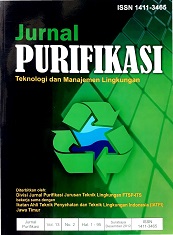PENURUNAN KANDUNGAN C ORGANIK DAN PEMBENTUKAN GAS PADA PROSES PENGOMPOSAN ECENG GONDOK
Main Article Content
Abstract
Domestic activities, industry and agriculture are causing many of the rivers in Indonesia have been contaminated by organic wastewater. It causes the water hyacinth thrive in water sources such as rivers and lakes. The purpose of this study was to determine the rate of decrease in organic carbon content to produce biogas which can be used as an alternate, energy. Experiments conducted on three reactors, two test reactor (reactor A and B) and one control reactor (reactor C). Raw materials as much as 15 kilograms of water hyacinth per reactor. A reactor was added Microorganisms M-16 and stirring. Reactor B was added Microorganisms M-16 and without stirring. Stirring is done ten rounds with a 360 ° rotating drum every day. The study was conducted over 60 days. The parameters analyzed were temperature, moisture content, pH and gas production were measured every day. Carbon and nitrogen were measured every 5 days. The results showed a decrease in the carbon content of 2.7 faster Reactor A and Reactor B Reactor 2 is faster than C. Formation of biogas in the reactor A 1.8 more than the reactor C and B Reactor 1.4 more than on Reactor C.
Downloads
Article Details
Submission of a manuscript to Jurnal Purifikasi means that the work has never been published in another journal and is not under consideration for publication elsewhere. The author hereby agrees to submit the copyright of the manuscript and its contents to Jurnal Purifikasi, if accepted for publication. Accepted manuscripts will be published in printed form where the ISSN is bound in printed form, not in online form (pdf). Authors are not allowed to publish their work in other forms (journals) without permission from the Jurnal Purifikasi manager.
By submitting a manuscript, the author is deemed to know all the rights and obligations attached to each manuscript.








